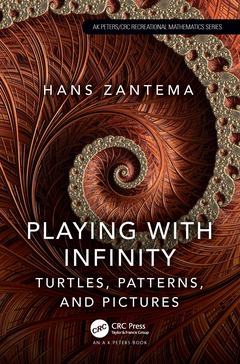Description
Playing with Infinity
Turtles, Patterns, and Pictures
AK Peters/CRC Recreational Mathematics Series
Author: Zantema Hans
Language: English
Subjects for Playing with Infinity:
Keywords
Infinity; number theory; math art; generative art; morphic; sequences
Publication date: 04-2024
· 15.6x23.4 cm · Paperback
Publication date: 04-2024
· 15.6x23.4 cm · Hardback
Description
/li>Contents
/li>Readership
/li>Biography
/li>
This is a book about infinity ? specifically the infinity of numbers, and how one kind of infinity is greater than all the rest. Along the way the author will demonstrate how infinity can be made to create beautiful ?art?, and how this process can help us to understand the fundamental nature of numbers. This book will provide a fascinating read for anyone interested in number theory, infinity, math art, and/or generative art, and could be used a valuable supplement to any course on these topics.
Features
- Beautiful examples of generative art.
- Accessible to anyone with a reasonable high school level of mathematics.
- Full of challenges and puzzles to engage readers.
1. What is this book about? 1.1. Infinitely many. 1.2. Infinite sequences and turtle figures. 1.3. Morphic sequences and symmetry. 1.4. Fractal turtle figures. 1.5. Mathematical challenges. 1.6. Who is this book for, how is it organized and how to read it? Challenge: the paint pot problem. 2. Numbers of the simplest kind. 2.1. Natural numbers. 2.2. Induction Strong induction. 2.3. Addition. 2.4. Multiplication. 2.5. Divisors and prime numbers. Challenge: number of divisors. 3. More complicated numbers. 3.1. Integer numbers. 3.2. Rational numbers. 3.3. Real numbers. 3.4. Complex numbers. Challenge: ten questions. 4. Flavors of infinity. 4.1. The Hilbert Hotel. 4.2. Smaller than? 4.3. Equal size? 4.4. Countable sets. 4.5. Uncountable sets. 4.6. Computable numbers. 4.7. Cardinal numbers. Challenge: monotone functions. 5 Infinite sequences. 5.1. Operations on sequences Morphisms. 5.2. Periodic and ultimately periodic sequences. 5.3. Decimal notation of numbers. 5.4. Frequency of symbols. 5.5. Challenge: the marble box. 6. Turtle figures. 6.1. Turtle figures of words and sequences. 6.2. Turtle figures of periodic sequences Some theory. 6.3. Finite turtle figures of periodic sequences. 6.4. Infinite turtle figures of periodic sequences. 6.5. Ultimately periodic sequences. Challenge: subword with zero angle. 7. Programming. 7.1. Turtle programming in Python. 7.2. Turtle programming in Lazarus. 7.3. Some theory. Challenge: knight moves. 8. More complicated sequences. 8.1. Random sequences. 8.2. The spiral sequence. 8.3. Pure morphic sequences. 8.4. Morphic sequences. 8.5. Programming morphic sequences. Challenge: a variation on the spiral sequence. 9. The Thue-Morse sequence. 9.1 A fair distribution. 9.2. The Thue-Morse sequence as a morphic sequence 9.3. Alternative characterizations. 9.4. Finite turtle figures of more general sequences. 9.5. Finite turtle figures of the Thue-Morse sequence. 9.6. Thue-Morse is cube free. 9.7. Stuttering variants of Thue-Morse. Challenge: finiteness in the spiral sequence. 10. More finite turtle figures. 10.1 A new theorem. 10.2. Two equal consecutive symbols. 10.3. Rosettes. 10.4. More Symbols. 10.5. Adding a tail. Challenge: one more finite turtle figure. 11. Fractal turtle figures. 11.1. Mandelbrot sets. 11.2. Fractal turtle figures. 11.3. The main theorem. 11.4. Examples with rotation. 11.5. Examples with u = u′. 11.6. Other examples. Challenge: googol. 12. Variations on Koch. 12.1. Koch curve. 12.2. Koch curve as a turtle figure. 12.3. Other scaling factors. 12.4. The period-doubling sequence. 12.5. Fractal turtle figures of variants of p. Challenge: googolplex. 13. Simple morphic sequences. 13.1. Koch-like turtle figures of Thue-Morse. 13.2. Relating t and p. 13.3. Finite turtle figures. 13.4. Other simple morphic sequences. 13.5. The binary Fibonacci sequence. 13.6. Turtle figures of the binary Fibonacci sequence. 13.7. Frequency of symbols in morphic sequences. Challenge: frequency of 1 percent. 14. Looking back. 14.1. Turtle figures of morphic sequences. 14.2. Other types of turtle figures. 14.3. More exciting pictures: cellular automata. 14.4. Mathematical challenges. 14.5. Almost infinite. Challenge: the greatest value.
Hans Zantema was born in 1956 in The Netherlands. He studied mathematics and received his PhD in pure mathematics in 1983. After a few years in industry he returned to university, in computer science. Apart from his position as an associate professor in computer science at Eindhoven University of Technology, from 2007 until his retirement in 2022 he was part time full professor at Radboud University in Nijmegen. His professional interest is mainly in mathematical reasoning, in particular applied to computation and automated reasoning. His hobbies include solving and designing logical puzzles.
These books may interest you

InfinityNew Research Frontiers 58.62 €


